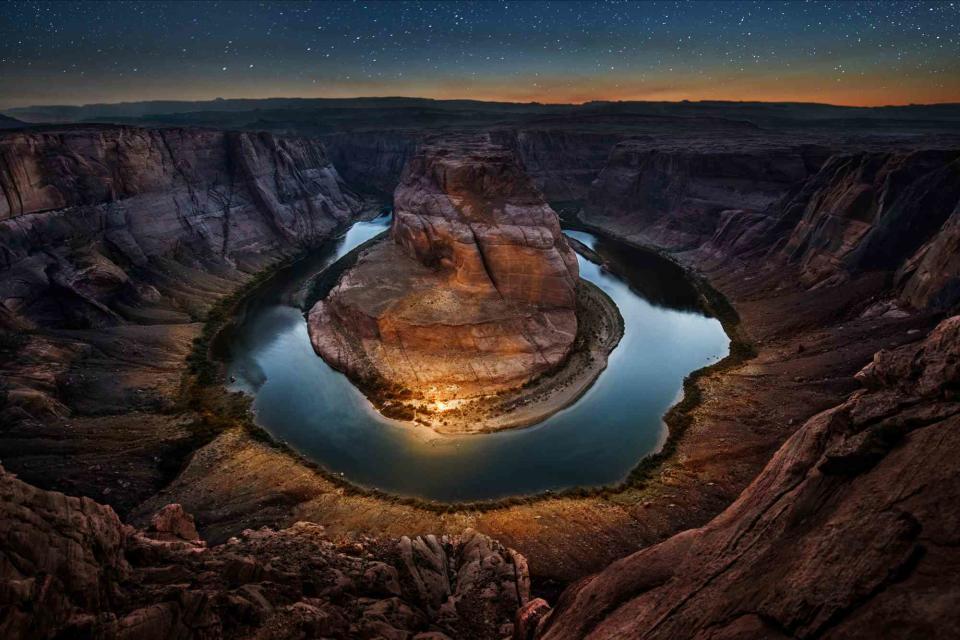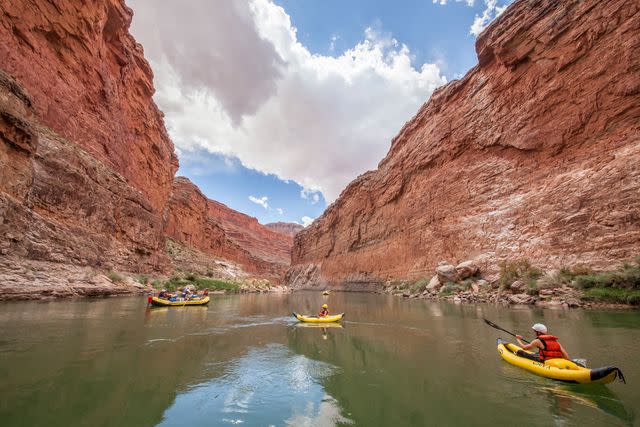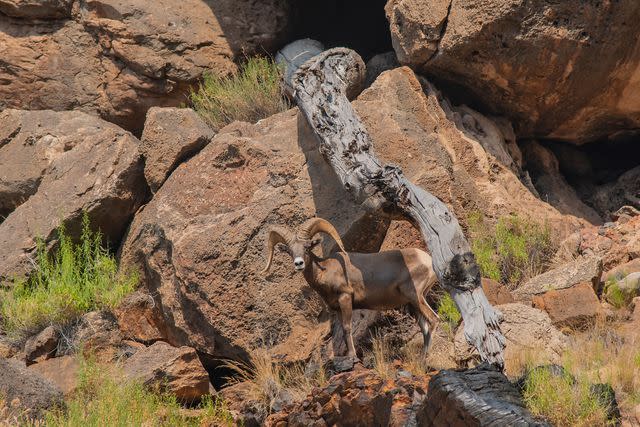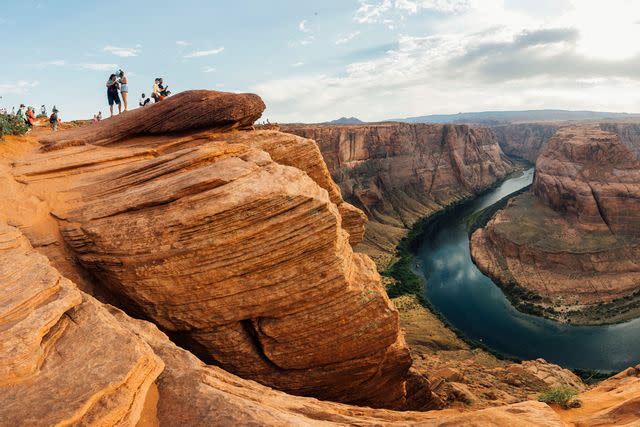Why I Went to Arizona's Horseshoe Bend to Come to Terms With My Daughter’s Passing
To help heal from a traumatic loss, author Jim Kristofic sought solace in nature on the Colorado River.

Cavan Images/Getty Images
Horseshoe Bend, a canyon with the Colorado River outside Page, Arizona. Trigger Warning: This article includes language about infant loss.
When visitors walk to the edge of Glen Canyon outside Page, Arizona, they see the famous landmark that’s in photographs all over the world: Horseshoe Bend, a curved flank of orange Navajo sandstone carved by the green water of Tóóh Bikooh, or, in English, the Colorado River. I’ve swam in that current countless times, first as a kid after my family moved to the Navajo Nation when I was seven years old, and later as a river guide in my teens and 20s. To the Indigenous Navajo people, those waters ignore words like “epoch” and “millennia.”
What many visitors might not know is that Horseshoe Bend is just one part of a canyon where tribes — the Anasazi, the Paiute, and the Diné (Navajo) — once grew crops, hunted, and lived and died for centuries. It’s also where I would have brought my daughter, if she had grown old enough to paddle a kayak. Now, I will never see her do this.

Merrill Images/Getty Images
Author Jim Kristofic spent much of his youth working as a guide on the Colorado River.In 1963, the Sierra Club pronounced that Glen Canyon, a stretch of nearly 200 miles of twisting, sinewy rock walls snaking from southern Utah into northern Arizona, was dead. The decade before, the Bureau of Reclamation had begun constructing the Glen Canyon Dam, and by the mid-1960s, a 700-foot tall wall of concrete had drowned most of Glen Canyon beneath the rising waters of what was then rechristened Lake Powell. The human rights of local Indigenous communities, which relied on the canyon for food, shelter, and spiritual rites, were blithely ignored. Just 16 miles of the canyon, including Horseshoe Bend, was spared. The majority of Glen Canyon’s ecosystem, along with more than 3,000 ancient home sites, was lost.
The Sierra Club and other environmental groups mourned that loss. Back in 1869, when the canyon was still intact and healthy, Major John Wesley Powell described gliding along the Colorado River “hour after hour,” stopping now and then as his attention was “arrested by some new wonder.” He journaled about “towering monuments,” “fern-decked alcoves,” and “oak-set glens” (hence the name).
But did the people who pronounced the death of this place stand at the overlook of Horseshoe Bend and see the plants and wildlife that still live there? The herons, the peregrine falcons, the bighorn sheep — do those animals know they’re living in a so-called “dead” landscape? What does it mean to die? No one knows but those who’ve done it.
My daughter knows. Less than a year ago, she was born and then passed away. She was four and a half pounds. I dug her grave, wrapped her in a baby blanket, and laid her in the earth. Now, I see her all the time. She is never where I am not.
Glen Canyon is sacred to the Navajo, the nation I was not born into but fortunate enough to learn from and grow up in. After my daughter’s passing, I decided to go to the canyon to make an offering and show the gods what had been taken away from me. Like the canyon, I wanted to show that things pronounced “dead” often find ways to live.
In June I drove to Page, Arizona, where I had rented a kayak from Kayak Lake Powell to chart 16 miles of the Colorado River. After another local outfitter, Wilderness River Adventures, hauled me upstream, I dropped my kayak at the beach closest to the dam. Amid willow trees near the shore, I found the remains of a great blue heron (táłtł’áá halééh, or “The One Who Walks on the Water”). The Diné believe the heron wandered along the rivers of the First World, a spiritual place at the beginning of time when all creation formed in darkness, and still invoke the bird in prayers for protection. The animals often speak for the diyin dine’é, the divine Great Ones. I buried its bones. I sobbed beside the river. I placed my feet into the cold water and splashed it on my neck.
Tó éí iina is a phrase that means “water is life.” When I returned to my kayak, I paddled under peregrine falcons and drifted beside green ferns growing along springs in the canyon wall. That night, when I set up a campsite, bats flitted through the yellow evening twilight. Beetles clicked across the sand, just like they did in the origin stories about the First World.
I tracked the planet turning by watching the stars disappear beyond the stony edges of the canyon rim, a thousand feet overhead. Those rocks formed when dinosaurs walked the earth, many worlds ago. Over time the Colorado River carved away what later became known as Glen Canyon, and what was buried lives again. I looked at the canyon in the moonlight. For this place to be here, I thought, so much had to be taken away.

William Dummitt/Getty Images
A desert bighorn sheep alongside the Colorado River.In the morning, I packed camp, refilled my water bottle from the river, and paddled downstream to find the place where I would make my offering. I had a tailfeather from né’éshjaa’, a great horned owl, the messenger between this world and the spirit world. The Diné use these feathers in ceremonial sand paintings and to help maintain healing.
On a bend in the river, I pulled my kayak to shore and hiked up a trail left by tsétah dibé, bighorn sheep. As I ascended the first sand embankment, the sheep emerged from the rocks in front of me. Four rams, 10 ewes, and four lambs watched me, less than 30 feet away. I greeted them in Navajo, then kept moving. The flock walked ahead of me like guides, over jagged stone and slippery sand. One ram led three of its fellows up a 30-foot cliff, into the shade of a small side canyon. As I walked past, the ram led them back down and stuck his head around the corner. His brown eyes bulged as he watched me, so close I could have stepped forward and touched his nose. The Diné say tsétah dibé carry magic and healing. In the culture’s spiritual compass, the tsétah dibé are creatures from the north, the black direction, the way of death and return. Perhaps the ram saw who walked beside me. I know my daughter was with me.
Eventually I came to a place where the river had formed a smooth bowl in the rock, where a hackberry tree grew close by. My daughter would have played here. I tied my feather offering to a green bough and watered the tree from water cupped in my hands.

Cavan Images/Getty Images
Today, Horseshoe Bend is a popular destination for travelers and photographers.The following day, my last on this trip, I returned the kayak and drove to Horseshoe Bend, where I stopped at the overlook. When I worked as a river guide twenty years ago, this place had been a small dirt turn-off next to a mile marker. Today, up to 10,000 people visit daily during peak season, coming through the town of Page to park their buses or cars at the overlook’s paved lot. A steel-fenced guardrail hugs the sheer edge of the canyon. As I stood there, visitors took photos with their smartphones in the 100-degree heat, including a group of Tibetan Buddhist monks in bright ochre robes. Crowds came and went, and people smiled often.
A thousand feet below, the Colorado River swerved quietly, carrying ducks and kayakers as it patiently dug into the rock, shaping and creating into eternity. It knows, perhaps, what I’ve learned, and others may learn: for all of this to be here, so much had to be taken away.
For more information about the Navajo Nation, visit www.navajo-nsn.gov.
For more Travel & Leisure news, make sure to sign up for our newsletter!
Read the original article on Travel & Leisure.

